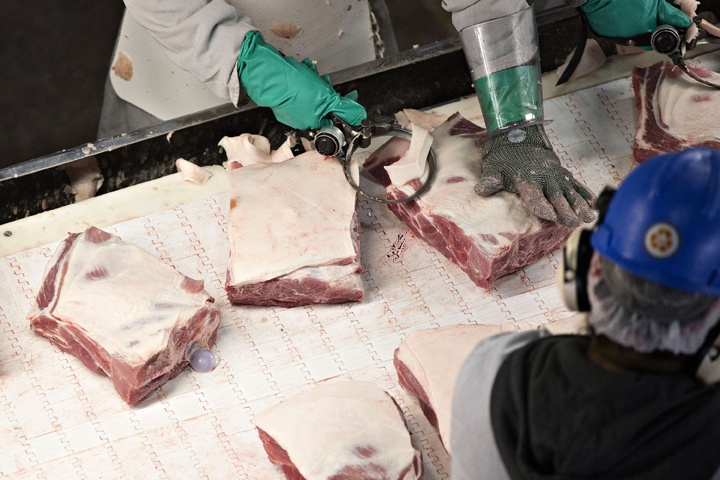
THE Philippines’s cold-chain industry has abundant space to accommodate the anticipated surge in pork imports as the government implements the additional 200,000 metric ton (MT) pork minimum access volume (MAV) or MAV plus, the industry association said on Monday.
According to Anthony S. Dizon, Cold Chain Association of the Philippines (CCAP) president, the industry has an aggregate capacity of 350,000 MT that can be dedicated to meat products, which is 75 percent higher than the approved MAV plus.
Dizon said the country’s lack of mechanically deboned meat (MDM) of chicken supply freed up a lot of space in cold storages nationwide.
“Receiving these supplies is not a problem. Our members are saying that they can greatly accommodate these volumes,” he said in an interview.
“The shipments will be coming in batches anyway, so the depletion rate will also play a role in capacity utilization,” he added.
Dizon urged the government to have an open database that would show the number of approved volume under pork MAV+ so that the cold-chain industry could closely monitor the import situation and make necessary adjustments to avert logistical bottlenecks.
“It would really be helpful if the government could share information on the list of approved SPS-ICs [sanitary and phytosanitary import clearances] and quantities involved to enable the cold-chain industry to also make advance preparations for capacity distribution,” he explained.
Dar’s timeline
Agriculture Secretary William D. Dar said it is “crucial” that 70 percent of the pork MAV+ to arrive and be distributed in the next four months to temper the country’s inflation rate, which was pegged at 4.5 percent in May.
The inflation rate of meat products in May was at 22.1 percent, based on Philippine Statistics Authority (PSA) data.
“It is very crucial because meat still appears in the latest food inflation—both in April and May. And even in June, it still appears. So it is very crucial that we are able to pull down meat prices and food inflation,” Dar told reporters in an interview on Monday.
Dar maintained that the government’s goal is to bring down pork retail prices to its pre-African Swine Fever level, which is below P300 per kilogram, through the Executive’s twin measure of reducing pork tariffs and hiking pork MAV.
The BusinessMirror broke the story on Monday that the MAV Management Committee (MAV-MC) has finally approved the guidelines for the pork MAV+, more than a month after Duterte ordered the increase of the MAV.
The BusinessMirror also reported that foreign meat suppliers are upbeat on their export outlook to the Philippines as they anticipate record-high pork shipments to the country this year. (Related story: https://businessmirror.com.ph/2021/06/28/pork-shipments-to-phl-could-hit-record-high-this-year-suppliers/)
Under the approved guidelines, about 70 percent or 140,000 MT of the total pork MAV+ must be distributed within July to October; while the remaining volume of 60,000 MT must be sold in Mega Manila-based wet markets, supermarkets and KADIWA centers from November to January 2022.
Logistical risks
However, Dizon flagged some risks that could affect the distribution of the country’s much needed pork supply from abroad.
For one, Dizon raised concerns regarding the capability of both the Bureau of Customs (BOC) and Philippine Ports Authority to process shipment arrivals “quickly” to “avoid port congestion.”
“Will BOC have enough E-TRACC [Electronic Tracking of Containerized Cargo] devices to go around?” he said. E-TRACC is the BOC’s platform to prevent smuggling by diversion.
Dizon also pointed out that if meat processors gain favorable access again to imported chicken MDM, then it may put a strain on the industry’s storage capacity.
Dizon noted that they are closely monitoring developments on the country’s chicken MDM imports as local meat processors continue to scramble for sources for the raw material.
“If the import shipments of both these commodities arrive at the same time, there could be a potential capacity issue, considering how hungry the processors are for MDM,” he said. “If supply lines suddenly open up, it could translate to a problematic capacity situation for the cold chain industry,” he added.
Europe, which accounts for 60 percent of the country’s chicken MDM supply, remains technically closed to local meat processors as the government has not lifted temporary import bans slapped on European countries with ongoing bird flu outbreaks.
The Netherlands, which meat processors could access for their much-needed raw materials, is having difficulties supplying the country’s chicken MDM requirement due to an import condition that bars them from sourcing chickens for MDM production from other countries.
The Netherlands accounts for about 40 percent of the country’s annual chicken MDM supply.
